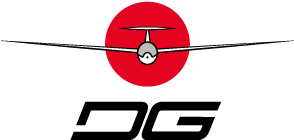BY THOMAS BERGMANN
published in Magazin “Segelfliegen” 6/2007
The racing class successor of Rolladen-Schneiders LS 3 was to be named LS 6. The Egelsbach company banked on a completely new development and the success in competitions and the market place confirmed that approach. The LS 6 launched for its maiden flight February 1983.
The production run of the 15 m racer then commenced in 1984. The new FRP fuselage with forward opening canopy and up-tilting instrument panel became more slender and narrower in favour of better aerodynamics. The emergency jettison system with rearward pivot point and dual release levers left and right set a new standard. The wheel brake was heel operated; the T-tail with conventional elevator did not contain a fin water tank in this first version. That included with the LS 6 a and a reinforced cockpit shell was integrated from the LS 8 onwards. This fuselage configuration remained basically unchanged up to the LS 10.
The new, with only 13.2 percent very thin wing for the first time incorporated carbon fiber reinforced rovings, resulting in superior stiffness. Wolf Lemke recycled the flaperons, a combination of flaps and ailerons along the complete trailing edge, from the LS 3. He returned however to the proven double trapeze geometry. The Wortmann wing section FX 81K-13o/17/FX 81-K-148/17 was used later also in the LS 8 and LS 9 and stands out for its insensitivity to bugs and wrongly positioned flaps. The top surface only extending airbrakes facilitate steep approach angles. Aileron and airbrakes however need to be connected manually with quick connects. A dampener was incorporated initially for flutter prevention, which made the controls somewhat stiff; a change of the wing skins and mass balance weights on ailerons made the measure redundant from the LS 6c onward. The water bags with centrally located discharge had a capacity of 140 l total.
The 17.5 m version of the LS 6c appeared 1990 without winglets but interchangeable wing tips. All control connections were now automatic. The subsequent LS 6c18 model with long wings could carry only 100 l of water. VNE in turn increased to 280 km/h. The final version of the LS 6-18w with winglets for the 15 m configurations as well returned to 150 l capacity water ballast tanks. Numerous competition successes guaranteed the LS 6 over 9 years an exalted position in racing class. Giesela Weinreich commenced the series of victories with wins of the German championship in 1984 and European championships 1985. Also 1985 the first two places were won at the world comps in Riety, followed 1987 by the first 3 places at the worlds in Australia, 1991 in Uvalde (USA) places 1 through to 4 and 1st and 2nd place again 1993 at the world championships in Sweden.
From 1995 onwards the further development LS 8 without flaps was built. 375 LS 6s in 6 different models were built from 1985 to 2003; 122 of them are still registered in, which puts the glider on 20th place in the ranking list.
At this point in time a used LS 6 including trailer trades from 27,000.- to 40,000.- Euro.
3-Dimensional Side View
List of Spare Parts
Technical Data
Type LS6, 6a and b (LS 6c17.5 . LS6c18 and 6-18)
Wingspan 15.00 m (17.50 / 18.00m)
Fuselage Length 6.66 m
Wing Area 10.5 m² (11.3 / 11.42 m²)
Aspect Ratio 21.43 (27.10 / 23.38)
Wing Section Wortmann FX 81K-13o/17/FX 81-K-148/17
Empty Weight 260 kg (275 280 kg)
Max. Pilot Weight 110 kg
Max. All Up Weight 525 kg
Max. Water Ballast 140 kg (104 kg)
Min. Wing Loading 32.9 kg / m² (33/29 kg / m²)
Max. Wing Loading 50 kg / m² (46 kg / m²)
Min. IAS 67 km / h
VNE 270 km / h (with 18 m 280 km / h)
Min. Sink 0.58 m / sec at 85 km / h (0.50 m / sec)
Best L/D 44 at 97 km / h (49 / 50)
Number Built 375
Period Built February 1984 (March 1990 / 1993) to 2003
Type Support:
DG Flugzeugbau GmbH
Otto-Lilienthal-Weg 2 / Am Flugplatz
D-76646 Bruchsal
Telefon: +49 (0) 72513020-0
e-mail: info@ls-flugzeugbau.de
internet: www.ls-flugzeugbau.de
formerly manufactured by:
Rolladen-Schneider Flugzeugbau, Egelsbach
Translation: Rolf Buelter, Australia
